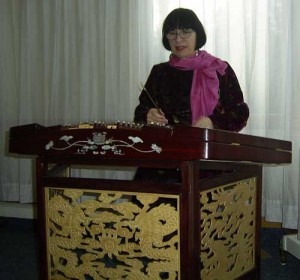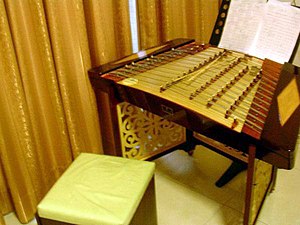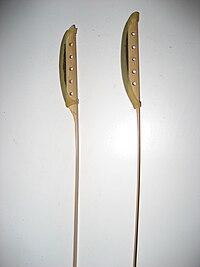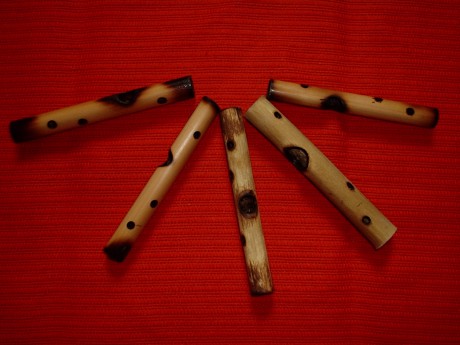Yangqin
Čínská verze cimbálu.

Yangqin
From Wikipedia, the free encyclopedia
| This article does not cite any references or sources. (November 2006) Please help improve this article by adding citations to reliable sources. Unverifiable material may be challenged and removed. |
The trapezoidal yangqin (simplified Chinese: 扬琴; traditional Chinese: 揚琴; pinyin: yángqín) is a Chinese hammered dulcimer originally from the Middle East (Persia (modern-day Iran)). It used to be written with the characters 洋琴 (lit. "foreign zither"), but over time the first character changed to 揚 (also pronounced "yáng"), which means "acclaimed". It is also spelled yang quin or yang ch'in. Hammered dulcimers of various types are now very popular not only in China, but also Eastern Europe, the Middle East, India and Pakistan. The instruments are also sometimes known by the names "santur" and "cymbalom".
The yangqin was traditionally fitted with bronze strings, which gave the instrument a soft timbre. This form of instrument is still occasionally heard today in the hudie qin (蝴蝶琴, lit. "butterfly zither") played in the traditional silk and bamboo genre from the Shanghai region known as Jiangnan sizhu (江南絲竹), as well as in some Cantonese music groups. The Thai and Cambodian khim are nearly identical in their construction, having been introduced to those nations by southern Chinese musicians. Since the 1950s, however, steel alloy strings (in conjunction with copper-wound steel strings for the bass notes) have been used, in order to give the instrument a brighter, and louder tone. The modern yangqin can have as many as five courses of bridges and may be arranged chromatically. Traditional instruments, with three or more courses of bridges, are also still widely in use. The instrument's strings are struck with two lightweight bamboo beaters (also known as hammers) with rubber tips. A professional musician often carries several sets of beaters, each of which draws a slightly different tone from the instrument, much like the drum sticks of Western percussionists.
The yangqin is used both as a solo instrument and in ensembles. Composer/vocalist Lisa Gerrard has used this instrument in the 8 albums recorded by the band Dead Can Dance and also in some of her performances solo since the break up of Dead Can Dance.
Contents[hide] |
[edit] Origins
Historians offer several theories to explain how the instrument was introduced to China: 1) that the instrument may have been introduced by land, through the Silk Road; 2) that it was introduced by sea, through the port of Guangzhou (Canton); or 3) that it was invented without foreign influence by the Chinese themselves.
The word "yangqin" has historically been written in two different ways, using different Chinese characters for "yang". The "yang" in the earlier version was written with the character 洋, meaning "foreign." It was later changed, in 1910, to the character "yang" (揚), meaning "acclaimed" and is also the first character of the name of Yangzhou (揚州 or 扬州) which some Chinese linguistic scholars[citation needed] have stated was done because the latter term was more politically correct during a period when China was resisting foreign cultural influences.
[edit] Theory of introduction by land
The by land theory of yangqin being bought into contact with the Chinese is through Silk Road. At the glance of the trading route of China, the Silk Route stretches almost 5,000 miles reaching to the Middle East, including Iran (Persia). The Iranian santur, a dulcimer, has existed since ancient times. If any dulcimer was to influence China by land, it is likely to be of this instrument.
The santur seems to be a likely predecessor of the yangqin. The instrument is somewhat smaller in size, is same in shape and is also played using two wooden mallets.
The technical structure of the santur is different in the way the tuning pegs are place, the bridges and the mallets. The yangqin's tuning pins are set in parallel instead of an angle 90 degree down at the side. The mallets of the santur also differ from those of the yangquin: they are made of wood with finger grip, designed to let the players perform by gripping the two mallets between their fore and middle fingers. The both modern and the earliest yangqin mallets did not include finger grips.
The bridge of the yangqin consist of long, single piece of wood with many stubs supporting the strings unlike the Santur which uses a number of small individual chesspiece-like bridges. The yangqin uses an individual bridge like the dulcimer instead of the santur.
[edit] Theory of introduction by sea
The seaport at Canton, Guangzhou attracts traders from all over Asia: from Japan, India, Southeast Asia, and the Middle East. The ships from this region bought back precious stones, slaves, exotic wares, fruits and spices etc. Along with commercial goods, thriving businesses, ideas, philosophies and scientific knowledge were exchanged including religion (principally Buddhism).
During the 16th century, the Age of Exploration in Europe reached it climax and soon trade was established between China and Europe. Historians state that Portuguese, and later, English and Dutch ships, had brisk trade with China. Portuguese trading in Chinese waters began in the 1500s according to historians. Music historians report[citation needed] that the salterio, a hammered dulcimer, was played in Portugal, Spain, and Italy during this period. Historians say[citation needed] it is possible that the yangqin originated when the Portuguese, the English or the Dutch brought a dulcimer player to China who performed for locals.
[edit] Possible relationship to clavichord
Some historians have stated[citation needed] that European clavichord is another possible precursor to the Yangqin. These historians state[citation needed] that Italian missionary Matteo Ricci had brought a clavichord from Europe to China and that the Chinese court had many clavichords and harpsichords in the palace, which were given as gifts by various European nations. However, as the locals could not duplicate the striking mechanism, they reverted to using hammers to hit the strings instead.
[edit] Theory of invention within China
Some music scholars support[citation needed] the theory that the Chinese dulcimer, yangqin was developed within China itself, devoid of all foreign influence. These historians state[citation needed] two possible explanations for the instruments native origins, which are: the yangqin is a development from an ancient string instrument called zhu (筑). Or that the yangqin originated from Yangzhou (扬州 or 揚州), China itself.
[edit] Relationship to the zhu
Some music scholars state[citation needed] that the yangqin developed from the ancient music instrument zhu (筑). The zhu is shaped like the guqin, rectangular with one side wider than the other. It had 12 to 13 strings (earliest variant only had 5 strings), assumed to have been made of silk or gut with resemblance to the guqin. It was performed using techniques quite similar to the guqin, one hand pressing the strings while the other pluck. However in the case of the zhu, instead of plucking the strings, it was struck by using a slender bamboo hammer. Like many string instruments, zhu is made of silk or gut.
[edit] The Yangzhou theory
Another theory supported[citation needed] by some music scholars is that the yangqin was developed in Yangzhou, a city in Jiangsu Province. According to one yangqin thesis written by Mr Chew in 1921, "Yangqin was named Yangqin because it was invented in Yangzhou, different variants came about after it was introduced into Guangzhou."[citation needed]
[edit] Construction
As the yangqin is a type of hammered dulcimer, it shares many elements of construction with other instruments in the hammered dulcimer family:
[edit] Strings
Modern yangqin usually have 144 strings in total, with each pitch running in courses, with up to 5 strings per course, in order to boost the volume. The strings come in various thicknesses, and are tied at one end by screws, and at the other with tuning pegs. The pegs and screws are covered during playing by a hinged panel/board. This panel is opened up during tuning to access the tuning pegs.
[edit] Bridges
There are usually four to five bridges on a yangqin. From right to left, they are: bass bridge, "left bridge", tenor bridge, "right bridge", and the chromatic bridge. During playing, one is supposed to strike the strings on the left side of the bridges. However, the strings on the "chromatic bridge" are struck on the right, and strings on the "right bridge" can be struck on both sides of the bridge.
[edit] Hammers
The hammers are made of flexible bamboo, and one end is half covered by rubber. Due to their unique construction, there are two ways to play: with the rubber side for a softer sound, and with the bamboo side for a more percussive sound. Additionally, the ends of the sticks can be used to pluck the strings, producing a sharp, clear sound.
[edit] Cylindrical nuts
On both sides of the yangqin, aside from the tuning screws, are numerous cylindrical metal Nuts that can be moved for fine tuning the strings or to raise the strings slightly to eliminate unwanted vibrations that may occur. More modern designs also have moveable ball-shaped nuts that can be adjusted on the fly with the fingers; this provides some microtuning and additional dynamics during performances.
[edit] Manner of Performance
The sticks are held, one in each hand, and hit the strings alternately. In the orchestra, the yangqin often adds to the harmony by playing chords or arpeggios. As the yangqin is softer than other Chinese instruments, it is usually positioned at the front of the orchestra, in the row just in front of the conductor. However, this is not a rule: the Singapore Chinese Orchestra positions the yangqin close to the percussion section. As the yangqin's tones sustain long after they have been played, such an arrangement minimizies the dissonance that results.[citation needed] If the hands are free (e.g. in periods of rest), covering the strings with the hands quickly dampens the vibrations. The yangqin has been called the "Chinese piano" as it has an indispensable role in the accompaniment of Chinese string and wind instruments.
[edit] Arrangement of Pitches
The yangqin is a chromatic instrument with a range of slightly over four octaves. The middle C is located at the tenor bridge, third section from the bottom.
The pitches are arranged so that in general, moving one section away from the body corresponds to a transposition of a whole tone upwards. Similarly, moving one section towards the left of the performer generally corresponds to a transposition of a perfect pitch upwards. These are only rules of thumb since the arrangement has to be modified towards the extremes of the pitch range to fill out notes in the chromatic scale. Such an arrangement facilitates transposition.
In the playing of traditional Chinese music, most Chinese yangqin players use a numerical notation system called jianpu, rather than Western staff notation.
[edit] Electric yangqin
The yangqin has also been modified, much like an electric guitar, to be an amplified electronic instrument.
[edit] Standard Repertory
- Solo pieces
- Joyous News (喜讯)
- San Liu (弹词三六)
- Song of the Border Region (边寨之歌)
- Opening the Well of Happiness with Our Hands (双手开出幸福泉)
- Spring Arrives to the Qing River (春到清江)
- Thunder During a Drought (旱天雷)
- Dragon Boat (龙船)
- A Festive at Tian Mountain (节日的天山)
- The General's Command (将军令)
- The Red Flower (映山红)
- The Dance of the Tu Tribe (土家族摆手舞曲)
- Lin Chong Flees in the Night (林冲夜奔)
- Ya Lu Zang Bu Riverside (雅鲁藏布江边)
- Huang Tu Qing (黄土情)
- Memory (忆事曲)
- Sound Poem of the Straits (海峡音诗)
- (金翎思-满乡随想)
- Yellow River(黄河)
[edit] External links
- Three pieces played on Yangqin
[edit] See also
| [hide]Traditional Chinese musical instruments | ||
|---|---|---|
| █ Silk (string): Plucked: Guqin • Se • Guzheng • Konghou • Pipa • Sanxian • Ruan • Liuqin • Yueqin • Qinqin • Duxianqin █ Bowed: Huqin • Erhu • Zhonghu • Gaohu • Banhu • Jinghu • Erxian • Tiqin • Yehu • Tuhu • Jiaohu • Sihu • Sanhu • Zhuihu • Zhuiqin • Leiqin • Dihu • (Xiaodihu • Zhongdihu • Dadihu) • Gehu • Diyingehu • Laruan • Matouqin • Yazheng █ Struck: Yangqin • Zhu | ||
| █ Bamboo (woodwind): Flutes: Dizi • Xiao • Paixiao • Koudi █ Oboes: Guan • Suona █ Free-reed pipes: Bawu • Mangtong | ||
| █ Gourd (woodwind): Sheng • Yu • Lusheng • Hulusi • Hulusheng | ||
| █ Percussion: Wood: Muyu • Guban █ Stone: Bianqing █ Metal: Bianzhong • Fangxiang • Luo • Yunluo █ Clay: Xun █ Hide: Daigu • Bangu • Paigu • Tanggu | ||
| █ Others: Gudi • Lusheng • Kouxian | ||
Categories: Articles lacking sources from November 2006 | All articles lacking sources | All articles with unsourced statements | Articles with unsourced statements since February 2007 | Articles with unsourced statements since June 2007 | Chinese musical instruments | Chordophones
Komentáře
Přehled komentářů
토토사이트
DataFast Proxies | Anonymous IPv6 Proxy
(FloydBuh, 28. 8. 2022 1:33)
[b]DataFast Proxies | IPv6 proxies[/b]
[i][b]Definitive Solution in IPv6 Proxy! [/b][/i]
[i]Anonymous IPv6 Proxy, undetectable on L2 and L3 Layers of the OSI model,
100% no DNS leak, no Header leak.[/i]
- IPv6 Proxy Geographically Referenced (Geographically Located).
- Rotating or Static IPv6 Proxy (Configurable).
- Dedicated IPv6 Proxy (Virgin IP Proxy).
- 100% Private IPv6 Proxy
- IPv6 proxy with Private server.
- Anti-Ban Agent
- Unlimited Traffic
- Zero Log
https://datafastproxies.com/
DataFast Proxies | IPv6 Proxy
(FloydBuh, 27. 8. 2022 6:08)
[b]DataFast Proxies | IPv6 proxies[/b]
[b]Highest Quality IPv6 Proxy![/b]
- Virgin IPv6 proxy
- Rotating or Static IPv6 Proxy
- Anonymous IPv6 proxy
[i]Definitive Solution in IPv6 Proxy Agent![/i]
https://datafastproxies.com/







토토사이트
(Bruceshulk, 29. 8. 2022 3:22)